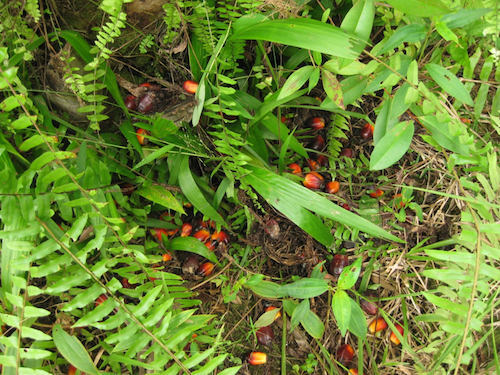Sustainable Oil Palm Farming / Circle weeding
| |
Download: Module 3: Plantation Maintenance
Contents
Goal
- Loose fruits on the ground are easy to spot and to collect (Figure 18)
- Harvesting can be carried out quickly and efficiently
- Efficient application and use of fertilisers
Standard
- Palm circles (1.5–2.0 m from the trunk in mature plantations) are completely weed-free
- Palm circles are free of rubbish
Timing
- Shortly before the peak season (so that harvesting can be done more efficiently)
- At the same time as path weeding (if possible)
- Not when rain is expected that day (otherwise the herbicide will be washed away)
Frequency
Every 2–4 months depending on the season and weed growth
Labour time required
- Manual weeding: 4 days per hectare
- Chemical weeding: 1 day per 2 hectares (together with path weeding)
Equipment and materials
- Manual weeding:
- - Chisel/spade
- - Bush knife
- - Rake
- Chemical weeding:
- - Knapsack sprayer
- - Protective clothing
- - Measuring cup (50–200 ml)
- - Clean water (100–200 L/ha)
- - Herbicide (0.5–1 L)
- - Rake
Who
Farmers and their families or hired labourers
How
Manual circle weeding
- Pull out all vegetation in the circle or cut vegetation to ground level with a bush knife, or alternatively scrape away all plants in the circle using a spade (see Figure 19)
- Rake weeds cut by a bush knife out of the circle
- Avoid ploughing or disturbing the soil in the circle because it can damage the palm roots
Chemical weeding
If the weeds are tall (more than 50 cm), it is best to start with one round of manual weeding and then to spray the young re-growing weeds after one month, or when the weeds are at ankle height using the following procedure:
| Step 1. | Make sure the sprayer is calibrated and working properly. |
| Step 2. | Prepare the herbicide according to the instructions on the package (see also Storing and spraying chemicals). |
| Step 3. | Select a nozzle that gives a spray of about 1 meter wide. |
| Step 4. | Spray the weed using the following technique:
Per hectare, expect to spray 100–200 L (0.5–2 L of herbicide), depending on the number of weeds. |
| Step 5. | Spray any re-growth one month after the first spraying to fully kill the weeds. |
Data recording
Every weeding activity should be recorded in a logbook as shown in the example below.
| Date | Time | Location | Activity | Input type | Input amount | Input costs | Labour input | Labour costs | |
| People | Hours | ||||||||
| 16/01/13 | Field 3 | Path and circle weeding | Round-Up | 1 L | 75000 | 1 | 8 | 80000 | |
Acknowledgements
The material from Circle weeding is sourced from Smallholder Oil Palm Handbook and put together by Lotte Suzanne Woittiez (Wageningen Universit) and Haryono Sadikin, Sri Turhina, Hidayat Dani, Tri Purba Dukan, and Hans Smit (SNV) in August 2016. See Module 3: Plantation Maintenance for more information.






